MNGT3011 - Change Management at Toyota: A Strategic CEO Briefing
VerifiedAdded on 2023/06/15
|20
|3943
|406
Report
AI Summary
This report examines the structural changes within Toyota Motors Corporation, driven by the need for improved decision-making, management oversight, and innovation. It focuses on the implementation of Kurt Lewin's 3-stage model (Unfreeze, Change, Refreeze) to facilitate these organizational changes. The report highlights strategic shifts in quality management, design and services, supply chain management, and inventory management. Furthermore, it explores change models like the 7S model, the star model, the congruence model, the Burke-Litwin model, and the four-frame model, offering a comprehensive overview of Toyota's change management approach and its implications for sustained growth and competitive advantage. This document is available on Desklib, where students can find a wide array of study resources including past papers and solved assignments.
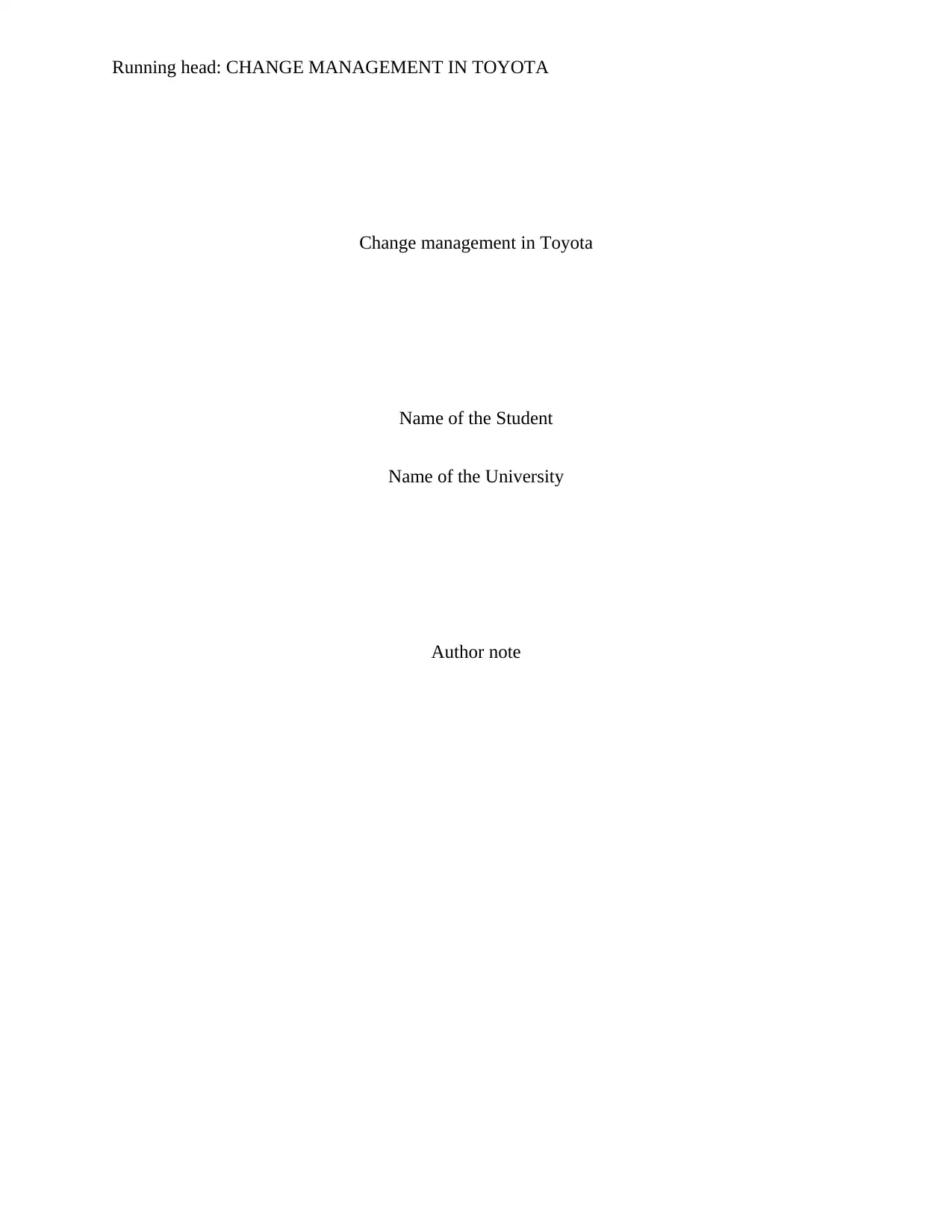
Running head: CHANGE MANAGEMENT IN TOYOTA
Change management in Toyota
Name of the Student
Name of the University
Author note
Change management in Toyota
Name of the Student
Name of the University
Author note
Paraphrase This Document
Need a fresh take? Get an instant paraphrase of this document with our AI Paraphraser
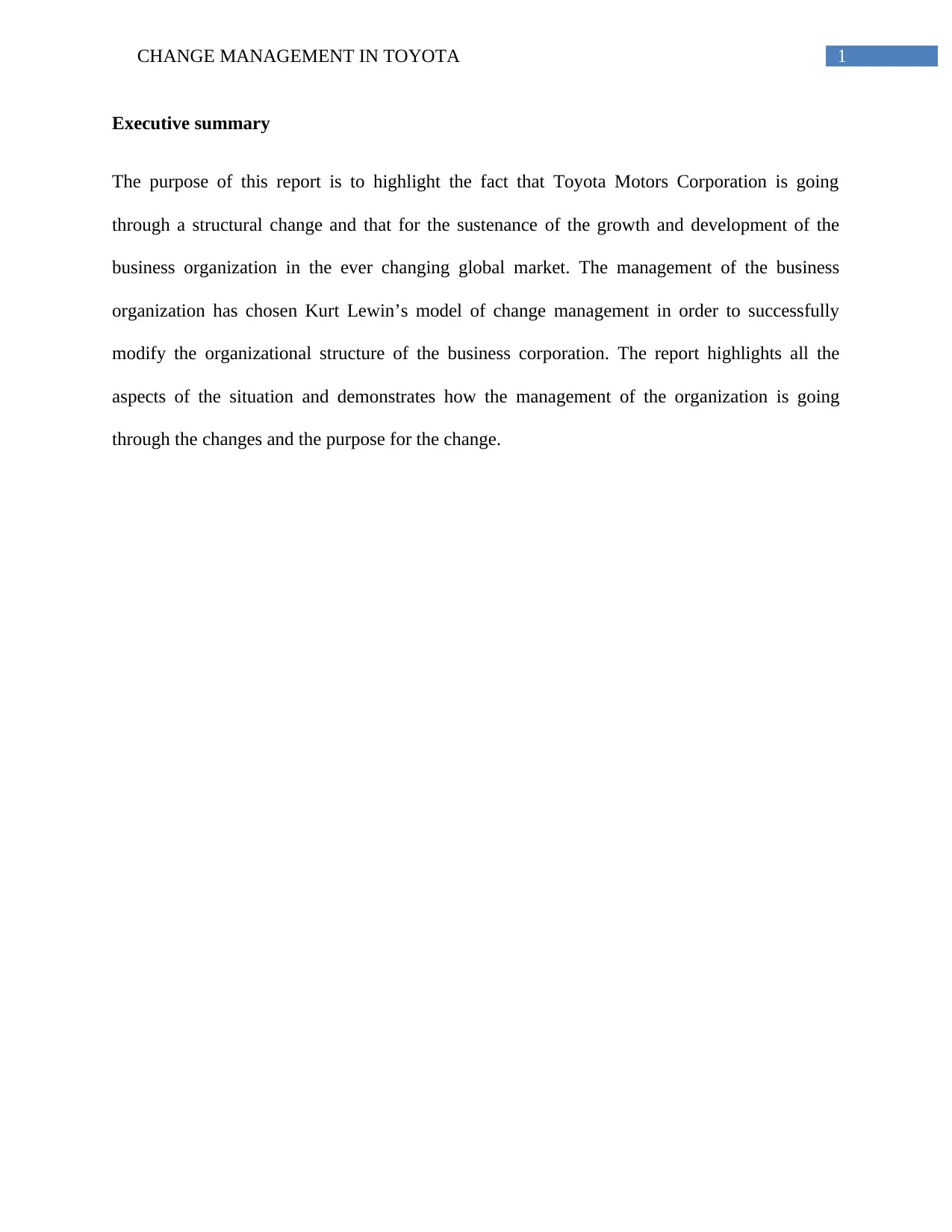
1CHANGE MANAGEMENT IN TOYOTA
Executive summary
The purpose of this report is to highlight the fact that Toyota Motors Corporation is going
through a structural change and that for the sustenance of the growth and development of the
business organization in the ever changing global market. The management of the business
organization has chosen Kurt Lewin’s model of change management in order to successfully
modify the organizational structure of the business corporation. The report highlights all the
aspects of the situation and demonstrates how the management of the organization is going
through the changes and the purpose for the change.
Executive summary
The purpose of this report is to highlight the fact that Toyota Motors Corporation is going
through a structural change and that for the sustenance of the growth and development of the
business organization in the ever changing global market. The management of the business
organization has chosen Kurt Lewin’s model of change management in order to successfully
modify the organizational structure of the business corporation. The report highlights all the
aspects of the situation and demonstrates how the management of the organization is going
through the changes and the purpose for the change.
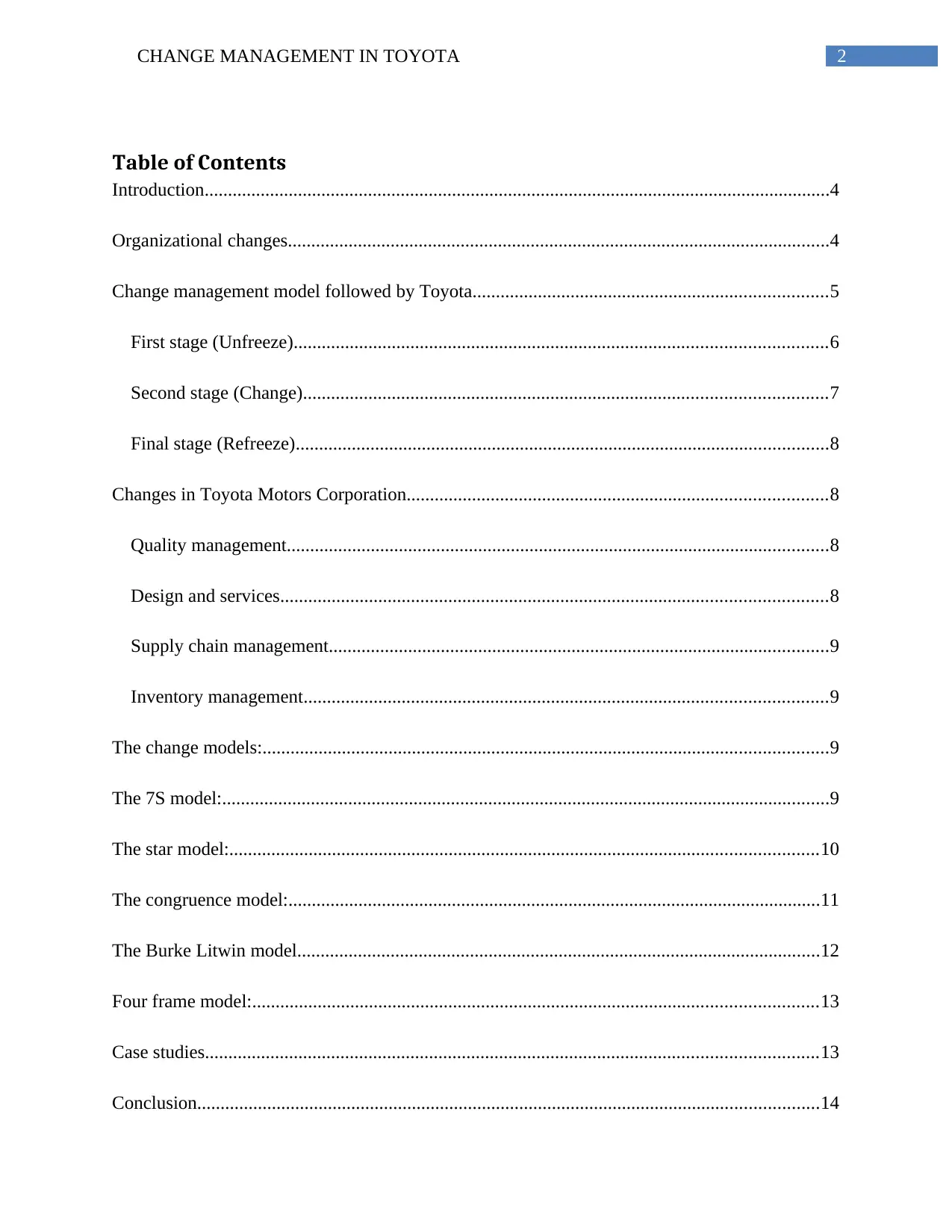
2CHANGE MANAGEMENT IN TOYOTA
Table of Contents
Introduction......................................................................................................................................4
Organizational changes....................................................................................................................4
Change management model followed by Toyota............................................................................5
First stage (Unfreeze)..................................................................................................................6
Second stage (Change)................................................................................................................7
Final stage (Refreeze)..................................................................................................................8
Changes in Toyota Motors Corporation..........................................................................................8
Quality management....................................................................................................................8
Design and services.....................................................................................................................8
Supply chain management...........................................................................................................9
Inventory management................................................................................................................9
The change models:.........................................................................................................................9
The 7S model:..................................................................................................................................9
The star model:..............................................................................................................................10
The congruence model:..................................................................................................................11
The Burke Litwin model................................................................................................................12
Four frame model:.........................................................................................................................13
Case studies...................................................................................................................................13
Conclusion.....................................................................................................................................14
Table of Contents
Introduction......................................................................................................................................4
Organizational changes....................................................................................................................4
Change management model followed by Toyota............................................................................5
First stage (Unfreeze)..................................................................................................................6
Second stage (Change)................................................................................................................7
Final stage (Refreeze)..................................................................................................................8
Changes in Toyota Motors Corporation..........................................................................................8
Quality management....................................................................................................................8
Design and services.....................................................................................................................8
Supply chain management...........................................................................................................9
Inventory management................................................................................................................9
The change models:.........................................................................................................................9
The 7S model:..................................................................................................................................9
The star model:..............................................................................................................................10
The congruence model:..................................................................................................................11
The Burke Litwin model................................................................................................................12
Four frame model:.........................................................................................................................13
Case studies...................................................................................................................................13
Conclusion.....................................................................................................................................14
⊘ This is a preview!⊘
Do you want full access?
Subscribe today to unlock all pages.

Trusted by 1+ million students worldwide
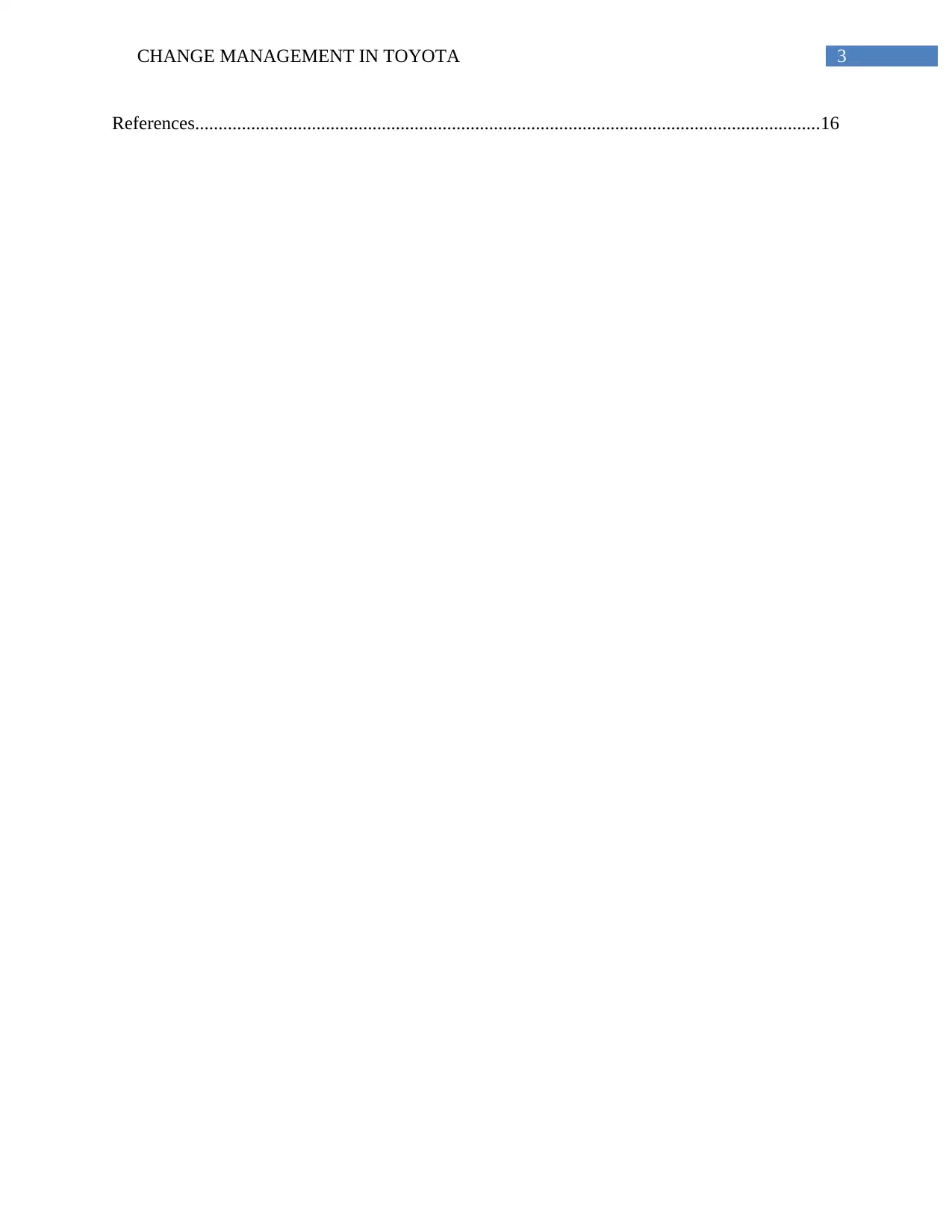
3CHANGE MANAGEMENT IN TOYOTA
References......................................................................................................................................16
References......................................................................................................................................16
Paraphrase This Document
Need a fresh take? Get an instant paraphrase of this document with our AI Paraphraser
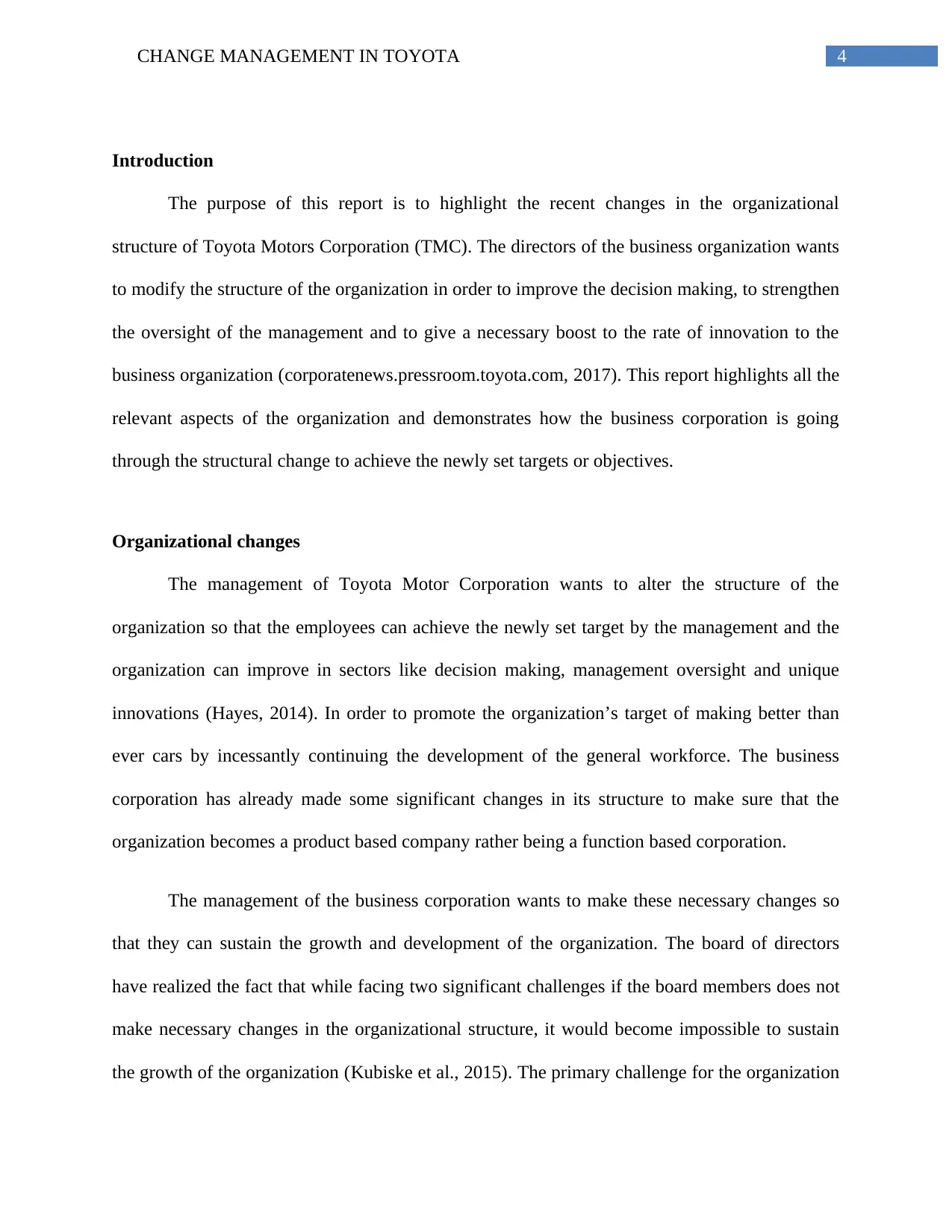
4CHANGE MANAGEMENT IN TOYOTA
Introduction
The purpose of this report is to highlight the recent changes in the organizational
structure of Toyota Motors Corporation (TMC). The directors of the business organization wants
to modify the structure of the organization in order to improve the decision making, to strengthen
the oversight of the management and to give a necessary boost to the rate of innovation to the
business organization (corporatenews.pressroom.toyota.com, 2017). This report highlights all the
relevant aspects of the organization and demonstrates how the business corporation is going
through the structural change to achieve the newly set targets or objectives.
Organizational changes
The management of Toyota Motor Corporation wants to alter the structure of the
organization so that the employees can achieve the newly set target by the management and the
organization can improve in sectors like decision making, management oversight and unique
innovations (Hayes, 2014). In order to promote the organization’s target of making better than
ever cars by incessantly continuing the development of the general workforce. The business
corporation has already made some significant changes in its structure to make sure that the
organization becomes a product based company rather being a function based corporation.
The management of the business corporation wants to make these necessary changes so
that they can sustain the growth and development of the organization. The board of directors
have realized the fact that while facing two significant challenges if the board members does not
make necessary changes in the organizational structure, it would become impossible to sustain
the growth of the organization (Kubiske et al., 2015). The primary challenge for the organization
Introduction
The purpose of this report is to highlight the recent changes in the organizational
structure of Toyota Motors Corporation (TMC). The directors of the business organization wants
to modify the structure of the organization in order to improve the decision making, to strengthen
the oversight of the management and to give a necessary boost to the rate of innovation to the
business organization (corporatenews.pressroom.toyota.com, 2017). This report highlights all the
relevant aspects of the organization and demonstrates how the business corporation is going
through the structural change to achieve the newly set targets or objectives.
Organizational changes
The management of Toyota Motor Corporation wants to alter the structure of the
organization so that the employees can achieve the newly set target by the management and the
organization can improve in sectors like decision making, management oversight and unique
innovations (Hayes, 2014). In order to promote the organization’s target of making better than
ever cars by incessantly continuing the development of the general workforce. The business
corporation has already made some significant changes in its structure to make sure that the
organization becomes a product based company rather being a function based corporation.
The management of the business corporation wants to make these necessary changes so
that they can sustain the growth and development of the organization. The board of directors
have realized the fact that while facing two significant challenges if the board members does not
make necessary changes in the organizational structure, it would become impossible to sustain
the growth of the organization (Kubiske et al., 2015). The primary challenge for the organization
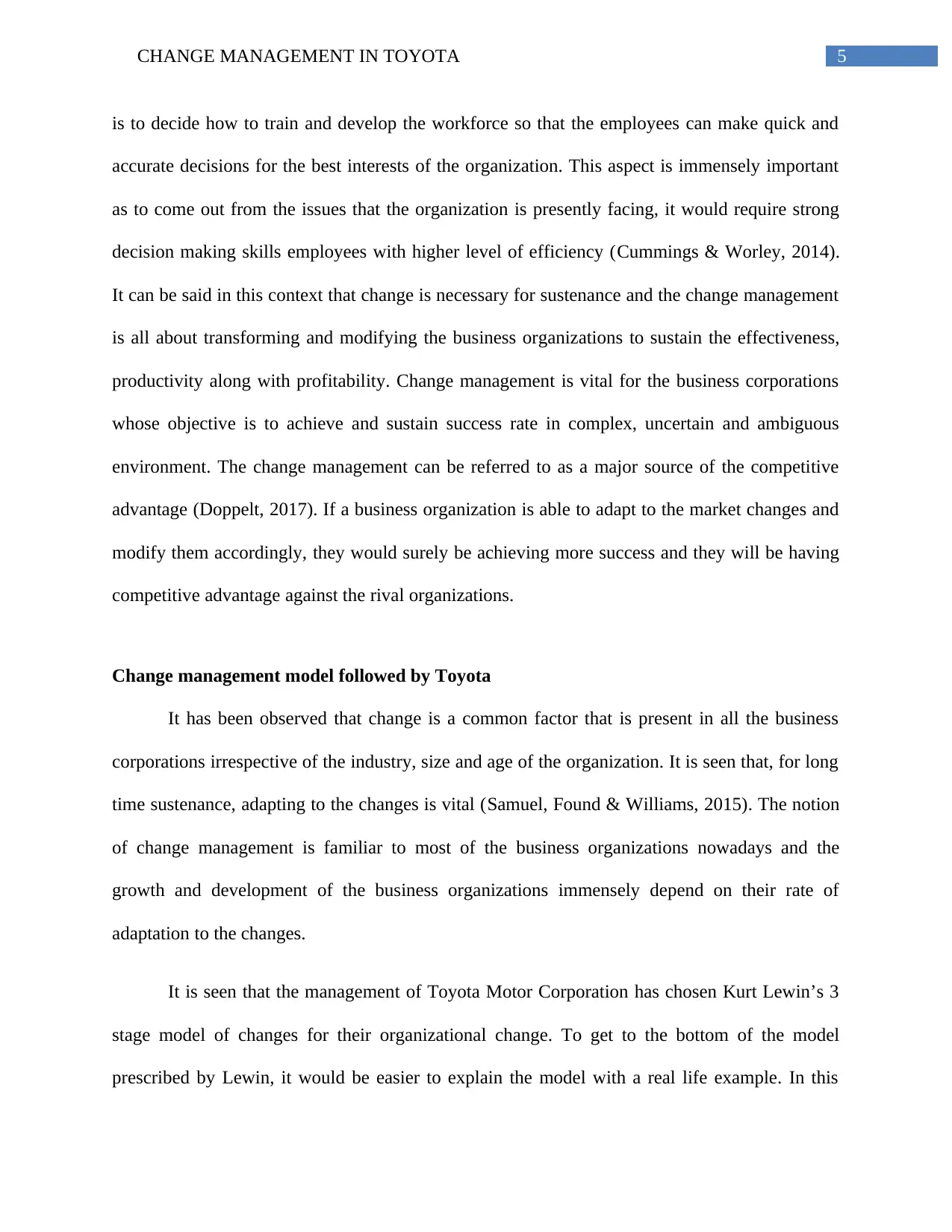
5CHANGE MANAGEMENT IN TOYOTA
is to decide how to train and develop the workforce so that the employees can make quick and
accurate decisions for the best interests of the organization. This aspect is immensely important
as to come out from the issues that the organization is presently facing, it would require strong
decision making skills employees with higher level of efficiency (Cummings & Worley, 2014).
It can be said in this context that change is necessary for sustenance and the change management
is all about transforming and modifying the business organizations to sustain the effectiveness,
productivity along with profitability. Change management is vital for the business corporations
whose objective is to achieve and sustain success rate in complex, uncertain and ambiguous
environment. The change management can be referred to as a major source of the competitive
advantage (Doppelt, 2017). If a business organization is able to adapt to the market changes and
modify them accordingly, they would surely be achieving more success and they will be having
competitive advantage against the rival organizations.
Change management model followed by Toyota
It has been observed that change is a common factor that is present in all the business
corporations irrespective of the industry, size and age of the organization. It is seen that, for long
time sustenance, adapting to the changes is vital (Samuel, Found & Williams, 2015). The notion
of change management is familiar to most of the business organizations nowadays and the
growth and development of the business organizations immensely depend on their rate of
adaptation to the changes.
It is seen that the management of Toyota Motor Corporation has chosen Kurt Lewin’s 3
stage model of changes for their organizational change. To get to the bottom of the model
prescribed by Lewin, it would be easier to explain the model with a real life example. In this
is to decide how to train and develop the workforce so that the employees can make quick and
accurate decisions for the best interests of the organization. This aspect is immensely important
as to come out from the issues that the organization is presently facing, it would require strong
decision making skills employees with higher level of efficiency (Cummings & Worley, 2014).
It can be said in this context that change is necessary for sustenance and the change management
is all about transforming and modifying the business organizations to sustain the effectiveness,
productivity along with profitability. Change management is vital for the business corporations
whose objective is to achieve and sustain success rate in complex, uncertain and ambiguous
environment. The change management can be referred to as a major source of the competitive
advantage (Doppelt, 2017). If a business organization is able to adapt to the market changes and
modify them accordingly, they would surely be achieving more success and they will be having
competitive advantage against the rival organizations.
Change management model followed by Toyota
It has been observed that change is a common factor that is present in all the business
corporations irrespective of the industry, size and age of the organization. It is seen that, for long
time sustenance, adapting to the changes is vital (Samuel, Found & Williams, 2015). The notion
of change management is familiar to most of the business organizations nowadays and the
growth and development of the business organizations immensely depend on their rate of
adaptation to the changes.
It is seen that the management of Toyota Motor Corporation has chosen Kurt Lewin’s 3
stage model of changes for their organizational change. To get to the bottom of the model
prescribed by Lewin, it would be easier to explain the model with a real life example. In this
⊘ This is a preview!⊘
Do you want full access?
Subscribe today to unlock all pages.

Trusted by 1+ million students worldwide
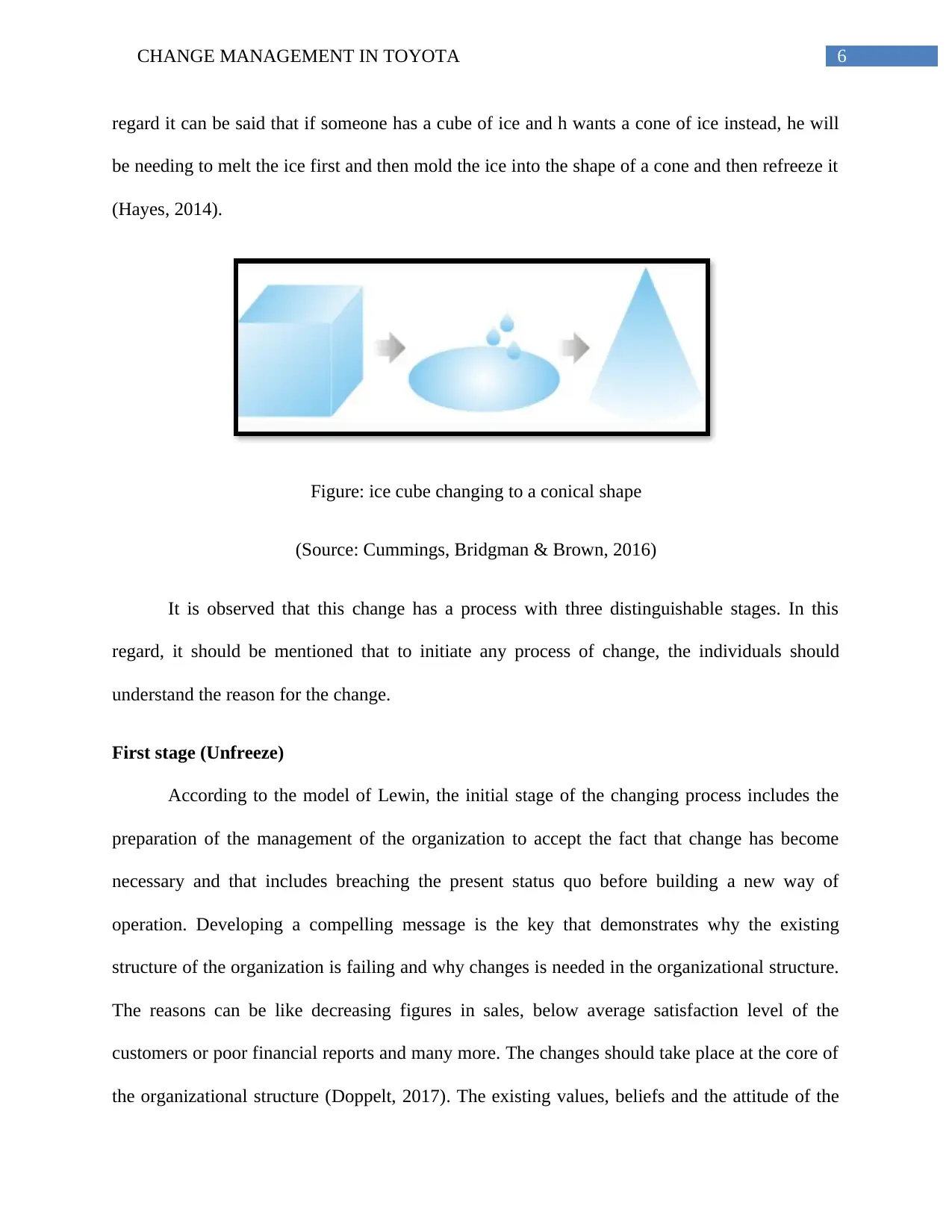
6CHANGE MANAGEMENT IN TOYOTA
regard it can be said that if someone has a cube of ice and h wants a cone of ice instead, he will
be needing to melt the ice first and then mold the ice into the shape of a cone and then refreeze it
(Hayes, 2014).
Figure: ice cube changing to a conical shape
(Source: Cummings, Bridgman & Brown, 2016)
It is observed that this change has a process with three distinguishable stages. In this
regard, it should be mentioned that to initiate any process of change, the individuals should
understand the reason for the change.
First stage (Unfreeze)
According to the model of Lewin, the initial stage of the changing process includes the
preparation of the management of the organization to accept the fact that change has become
necessary and that includes breaching the present status quo before building a new way of
operation. Developing a compelling message is the key that demonstrates why the existing
structure of the organization is failing and why changes is needed in the organizational structure.
The reasons can be like decreasing figures in sales, below average satisfaction level of the
customers or poor financial reports and many more. The changes should take place at the core of
the organizational structure (Doppelt, 2017). The existing values, beliefs and the attitude of the
regard it can be said that if someone has a cube of ice and h wants a cone of ice instead, he will
be needing to melt the ice first and then mold the ice into the shape of a cone and then refreeze it
(Hayes, 2014).
Figure: ice cube changing to a conical shape
(Source: Cummings, Bridgman & Brown, 2016)
It is observed that this change has a process with three distinguishable stages. In this
regard, it should be mentioned that to initiate any process of change, the individuals should
understand the reason for the change.
First stage (Unfreeze)
According to the model of Lewin, the initial stage of the changing process includes the
preparation of the management of the organization to accept the fact that change has become
necessary and that includes breaching the present status quo before building a new way of
operation. Developing a compelling message is the key that demonstrates why the existing
structure of the organization is failing and why changes is needed in the organizational structure.
The reasons can be like decreasing figures in sales, below average satisfaction level of the
customers or poor financial reports and many more. The changes should take place at the core of
the organizational structure (Doppelt, 2017). The existing values, beliefs and the attitude of the
Paraphrase This Document
Need a fresh take? Get an instant paraphrase of this document with our AI Paraphraser
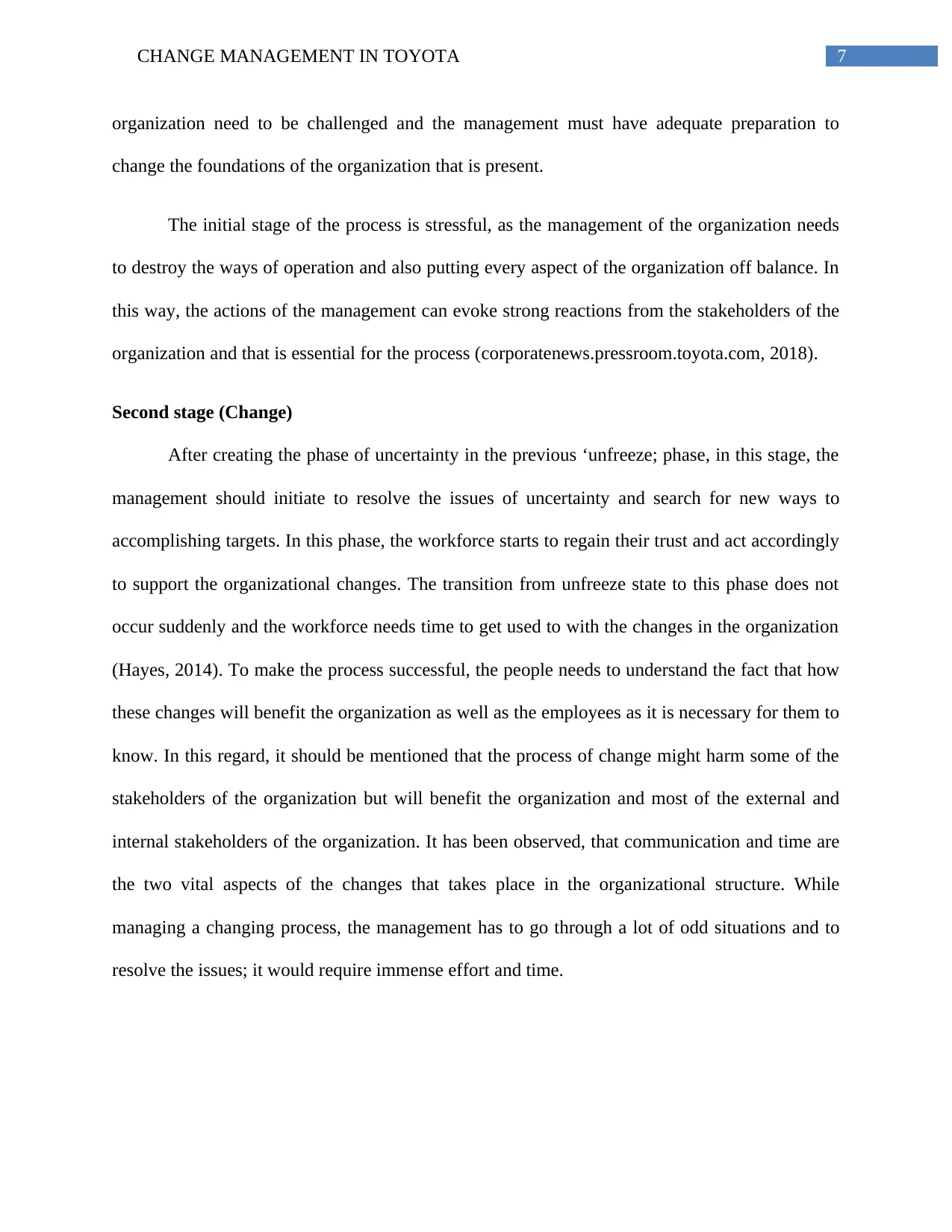
7CHANGE MANAGEMENT IN TOYOTA
organization need to be challenged and the management must have adequate preparation to
change the foundations of the organization that is present.
The initial stage of the process is stressful, as the management of the organization needs
to destroy the ways of operation and also putting every aspect of the organization off balance. In
this way, the actions of the management can evoke strong reactions from the stakeholders of the
organization and that is essential for the process (corporatenews.pressroom.toyota.com, 2018).
Second stage (Change)
After creating the phase of uncertainty in the previous ‘unfreeze; phase, in this stage, the
management should initiate to resolve the issues of uncertainty and search for new ways to
accomplishing targets. In this phase, the workforce starts to regain their trust and act accordingly
to support the organizational changes. The transition from unfreeze state to this phase does not
occur suddenly and the workforce needs time to get used to with the changes in the organization
(Hayes, 2014). To make the process successful, the people needs to understand the fact that how
these changes will benefit the organization as well as the employees as it is necessary for them to
know. In this regard, it should be mentioned that the process of change might harm some of the
stakeholders of the organization but will benefit the organization and most of the external and
internal stakeholders of the organization. It has been observed, that communication and time are
the two vital aspects of the changes that takes place in the organizational structure. While
managing a changing process, the management has to go through a lot of odd situations and to
resolve the issues; it would require immense effort and time.
organization need to be challenged and the management must have adequate preparation to
change the foundations of the organization that is present.
The initial stage of the process is stressful, as the management of the organization needs
to destroy the ways of operation and also putting every aspect of the organization off balance. In
this way, the actions of the management can evoke strong reactions from the stakeholders of the
organization and that is essential for the process (corporatenews.pressroom.toyota.com, 2018).
Second stage (Change)
After creating the phase of uncertainty in the previous ‘unfreeze; phase, in this stage, the
management should initiate to resolve the issues of uncertainty and search for new ways to
accomplishing targets. In this phase, the workforce starts to regain their trust and act accordingly
to support the organizational changes. The transition from unfreeze state to this phase does not
occur suddenly and the workforce needs time to get used to with the changes in the organization
(Hayes, 2014). To make the process successful, the people needs to understand the fact that how
these changes will benefit the organization as well as the employees as it is necessary for them to
know. In this regard, it should be mentioned that the process of change might harm some of the
stakeholders of the organization but will benefit the organization and most of the external and
internal stakeholders of the organization. It has been observed, that communication and time are
the two vital aspects of the changes that takes place in the organizational structure. While
managing a changing process, the management has to go through a lot of odd situations and to
resolve the issues; it would require immense effort and time.
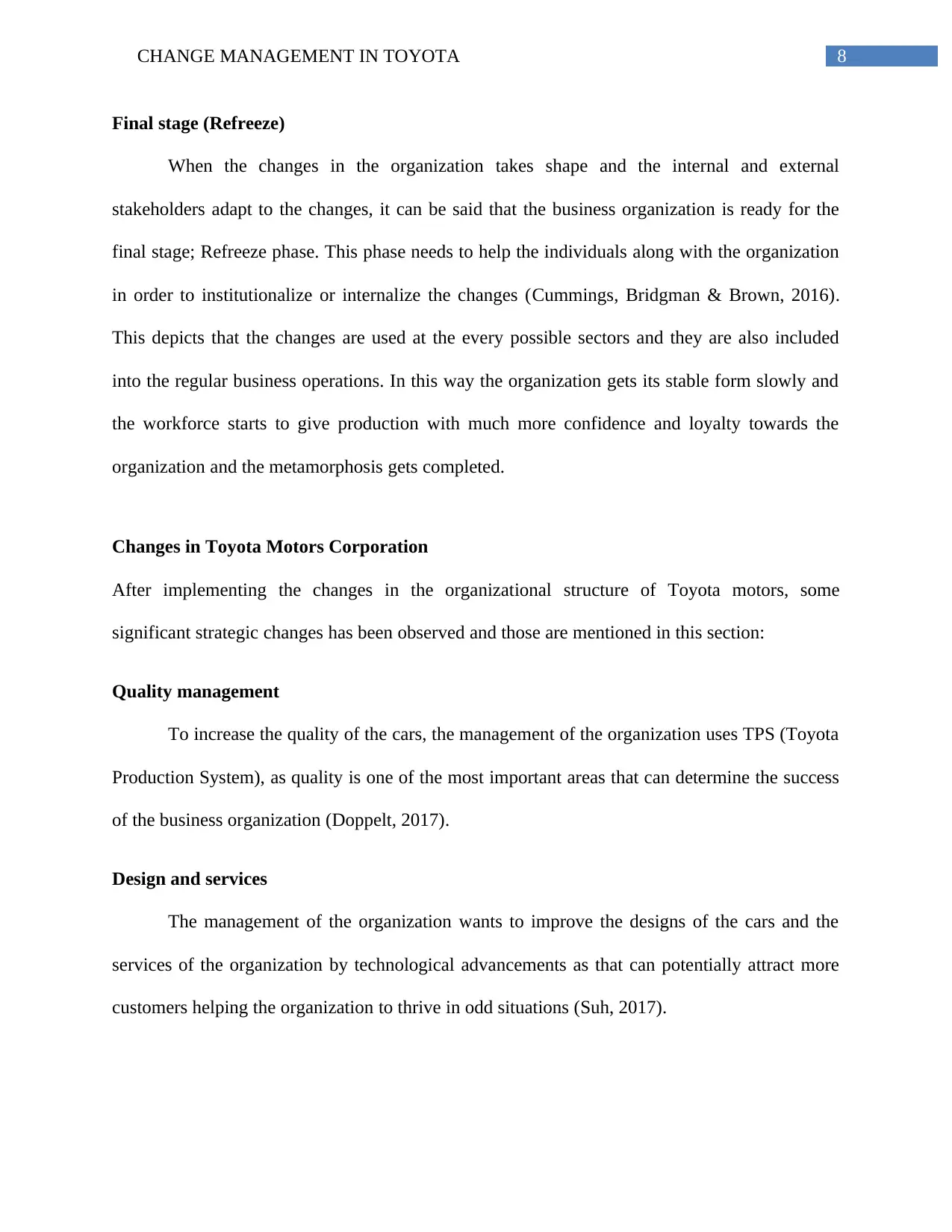
8CHANGE MANAGEMENT IN TOYOTA
Final stage (Refreeze)
When the changes in the organization takes shape and the internal and external
stakeholders adapt to the changes, it can be said that the business organization is ready for the
final stage; Refreeze phase. This phase needs to help the individuals along with the organization
in order to institutionalize or internalize the changes (Cummings, Bridgman & Brown, 2016).
This depicts that the changes are used at the every possible sectors and they are also included
into the regular business operations. In this way the organization gets its stable form slowly and
the workforce starts to give production with much more confidence and loyalty towards the
organization and the metamorphosis gets completed.
Changes in Toyota Motors Corporation
After implementing the changes in the organizational structure of Toyota motors, some
significant strategic changes has been observed and those are mentioned in this section:
Quality management
To increase the quality of the cars, the management of the organization uses TPS (Toyota
Production System), as quality is one of the most important areas that can determine the success
of the business organization (Doppelt, 2017).
Design and services
The management of the organization wants to improve the designs of the cars and the
services of the organization by technological advancements as that can potentially attract more
customers helping the organization to thrive in odd situations (Suh, 2017).
Final stage (Refreeze)
When the changes in the organization takes shape and the internal and external
stakeholders adapt to the changes, it can be said that the business organization is ready for the
final stage; Refreeze phase. This phase needs to help the individuals along with the organization
in order to institutionalize or internalize the changes (Cummings, Bridgman & Brown, 2016).
This depicts that the changes are used at the every possible sectors and they are also included
into the regular business operations. In this way the organization gets its stable form slowly and
the workforce starts to give production with much more confidence and loyalty towards the
organization and the metamorphosis gets completed.
Changes in Toyota Motors Corporation
After implementing the changes in the organizational structure of Toyota motors, some
significant strategic changes has been observed and those are mentioned in this section:
Quality management
To increase the quality of the cars, the management of the organization uses TPS (Toyota
Production System), as quality is one of the most important areas that can determine the success
of the business organization (Doppelt, 2017).
Design and services
The management of the organization wants to improve the designs of the cars and the
services of the organization by technological advancements as that can potentially attract more
customers helping the organization to thrive in odd situations (Suh, 2017).
⊘ This is a preview!⊘
Do you want full access?
Subscribe today to unlock all pages.

Trusted by 1+ million students worldwide
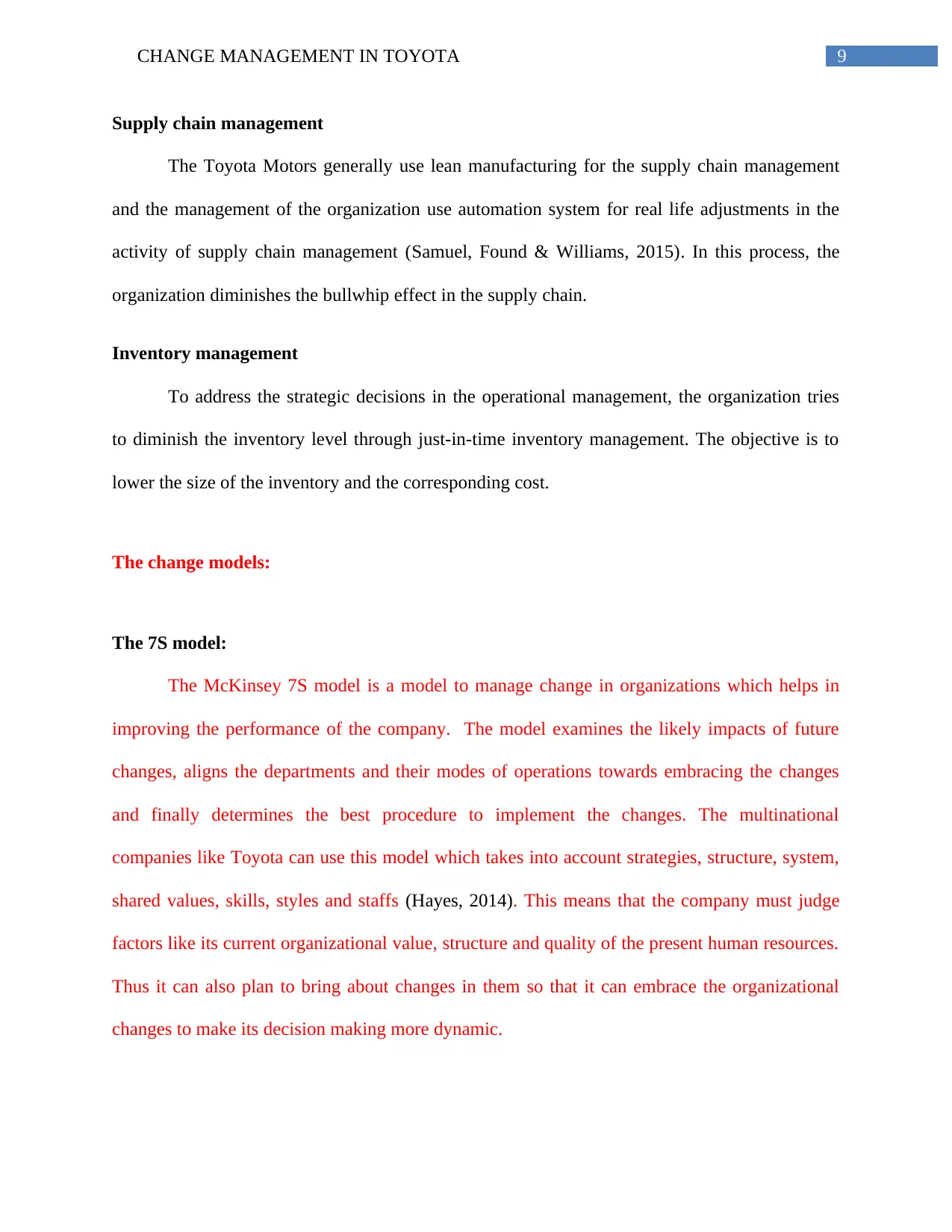
9CHANGE MANAGEMENT IN TOYOTA
Supply chain management
The Toyota Motors generally use lean manufacturing for the supply chain management
and the management of the organization use automation system for real life adjustments in the
activity of supply chain management (Samuel, Found & Williams, 2015). In this process, the
organization diminishes the bullwhip effect in the supply chain.
Inventory management
To address the strategic decisions in the operational management, the organization tries
to diminish the inventory level through just-in-time inventory management. The objective is to
lower the size of the inventory and the corresponding cost.
The change models:
The 7S model:
The McKinsey 7S model is a model to manage change in organizations which helps in
improving the performance of the company. The model examines the likely impacts of future
changes, aligns the departments and their modes of operations towards embracing the changes
and finally determines the best procedure to implement the changes. The multinational
companies like Toyota can use this model which takes into account strategies, structure, system,
shared values, skills, styles and staffs (Hayes, 2014). This means that the company must judge
factors like its current organizational value, structure and quality of the present human resources.
Thus it can also plan to bring about changes in them so that it can embrace the organizational
changes to make its decision making more dynamic.
Supply chain management
The Toyota Motors generally use lean manufacturing for the supply chain management
and the management of the organization use automation system for real life adjustments in the
activity of supply chain management (Samuel, Found & Williams, 2015). In this process, the
organization diminishes the bullwhip effect in the supply chain.
Inventory management
To address the strategic decisions in the operational management, the organization tries
to diminish the inventory level through just-in-time inventory management. The objective is to
lower the size of the inventory and the corresponding cost.
The change models:
The 7S model:
The McKinsey 7S model is a model to manage change in organizations which helps in
improving the performance of the company. The model examines the likely impacts of future
changes, aligns the departments and their modes of operations towards embracing the changes
and finally determines the best procedure to implement the changes. The multinational
companies like Toyota can use this model which takes into account strategies, structure, system,
shared values, skills, styles and staffs (Hayes, 2014). This means that the company must judge
factors like its current organizational value, structure and quality of the present human resources.
Thus it can also plan to bring about changes in them so that it can embrace the organizational
changes to make its decision making more dynamic.
Paraphrase This Document
Need a fresh take? Get an instant paraphrase of this document with our AI Paraphraser
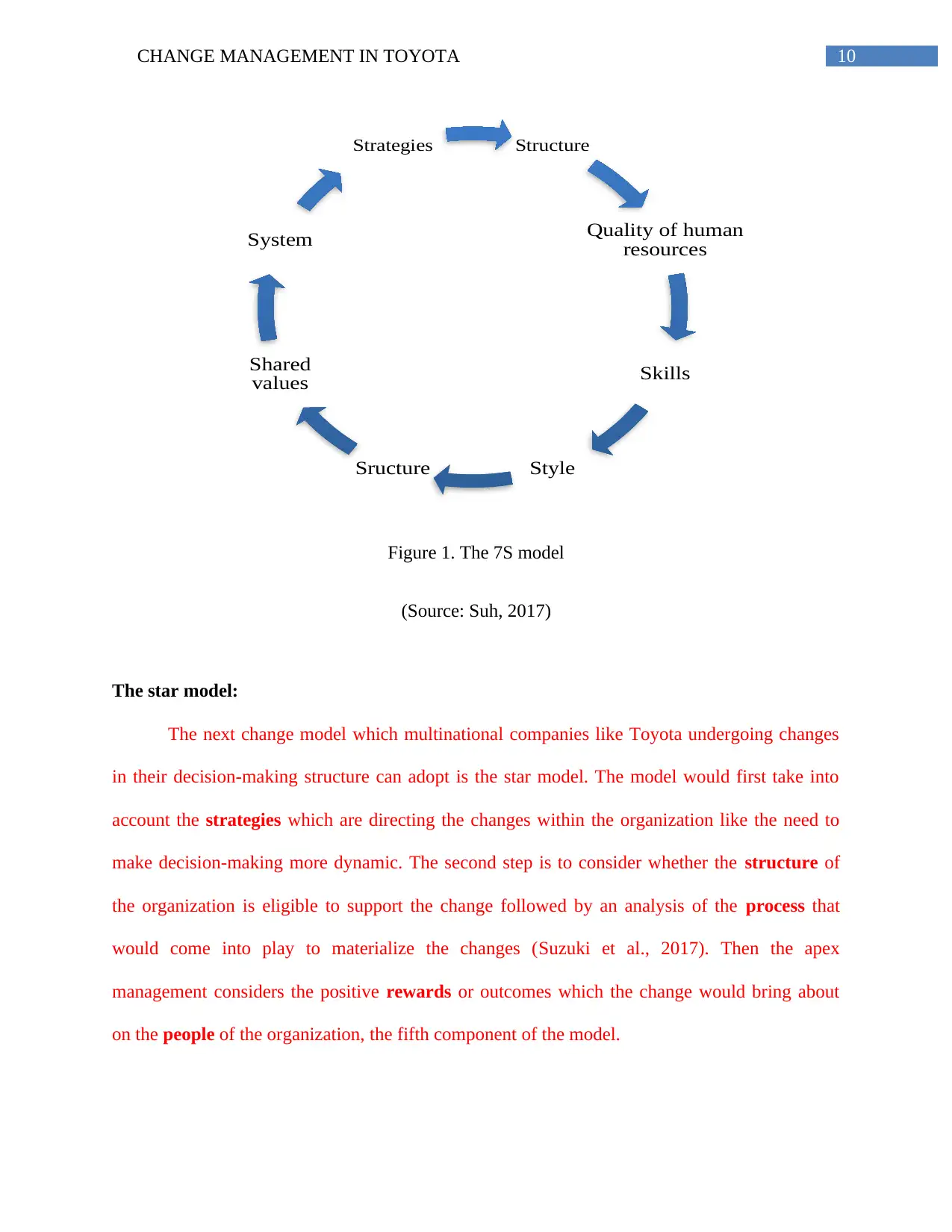
10CHANGE MANAGEMENT IN TOYOTA
Figure 1. The 7S model
(Source: Suh, 2017)
The star model:
The next change model which multinational companies like Toyota undergoing changes
in their decision-making structure can adopt is the star model. The model would first take into
account the strategies which are directing the changes within the organization like the need to
make decision-making more dynamic. The second step is to consider whether the structure of
the organization is eligible to support the change followed by an analysis of the process that
would come into play to materialize the changes (Suzuki et al., 2017). Then the apex
management considers the positive rewards or outcomes which the change would bring about
on the people of the organization, the fifth component of the model.
Structure
Quality of human
resources
Skills
StyleSructure
Shared
values
System
Strategies
Figure 1. The 7S model
(Source: Suh, 2017)
The star model:
The next change model which multinational companies like Toyota undergoing changes
in their decision-making structure can adopt is the star model. The model would first take into
account the strategies which are directing the changes within the organization like the need to
make decision-making more dynamic. The second step is to consider whether the structure of
the organization is eligible to support the change followed by an analysis of the process that
would come into play to materialize the changes (Suzuki et al., 2017). Then the apex
management considers the positive rewards or outcomes which the change would bring about
on the people of the organization, the fifth component of the model.
Structure
Quality of human
resources
Skills
StyleSructure
Shared
values
System
Strategies
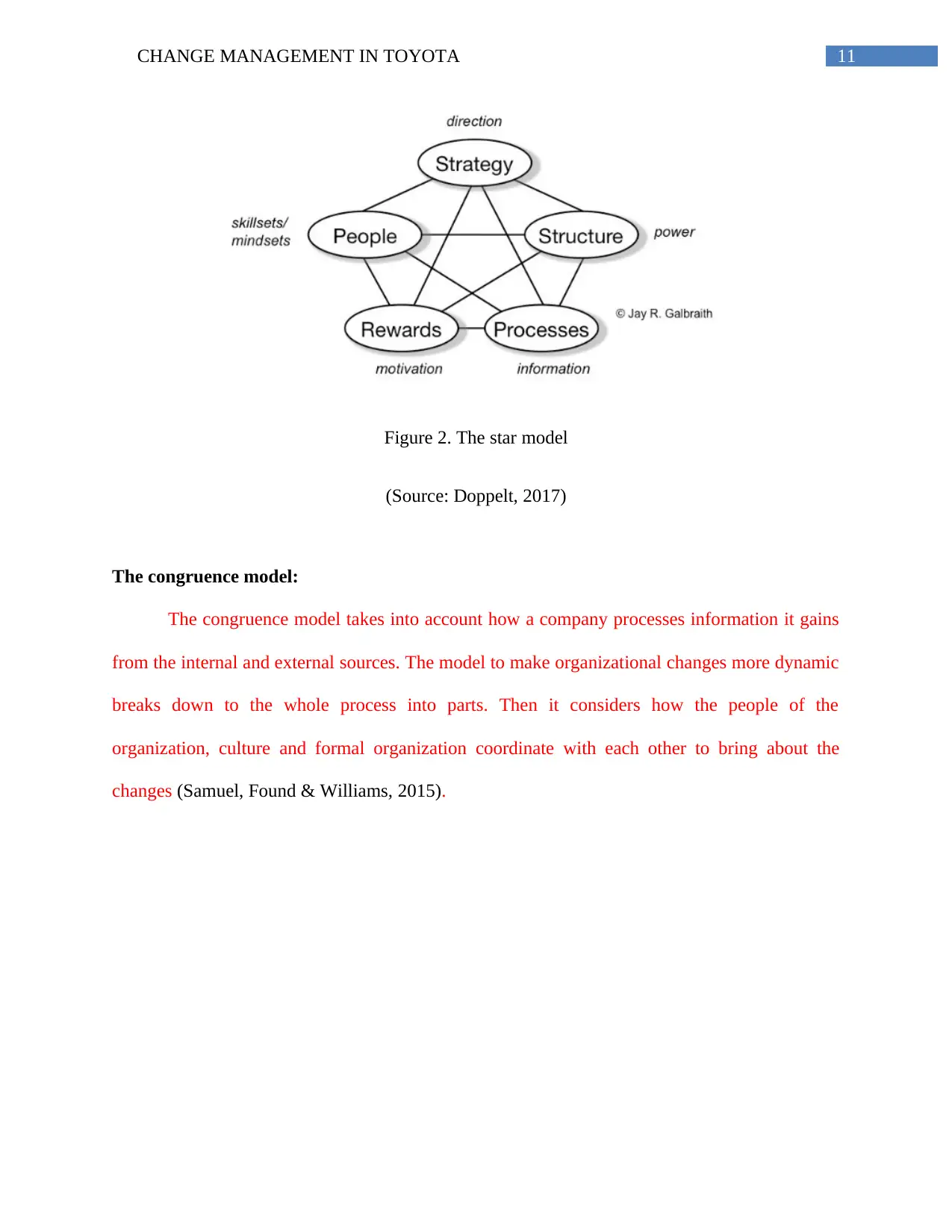
11CHANGE MANAGEMENT IN TOYOTA
Figure 2. The star model
(Source: Doppelt, 2017)
The congruence model:
The congruence model takes into account how a company processes information it gains
from the internal and external sources. The model to make organizational changes more dynamic
breaks down to the whole process into parts. Then it considers how the people of the
organization, culture and formal organization coordinate with each other to bring about the
changes (Samuel, Found & Williams, 2015).
Figure 2. The star model
(Source: Doppelt, 2017)
The congruence model:
The congruence model takes into account how a company processes information it gains
from the internal and external sources. The model to make organizational changes more dynamic
breaks down to the whole process into parts. Then it considers how the people of the
organization, culture and formal organization coordinate with each other to bring about the
changes (Samuel, Found & Williams, 2015).
⊘ This is a preview!⊘
Do you want full access?
Subscribe today to unlock all pages.

Trusted by 1+ million students worldwide
1 out of 20
Related Documents
Your All-in-One AI-Powered Toolkit for Academic Success.
+13062052269
info@desklib.com
Available 24*7 on WhatsApp / Email
![[object Object]](/_next/static/media/star-bottom.7253800d.svg)
Unlock your academic potential
Copyright © 2020–2025 A2Z Services. All Rights Reserved. Developed and managed by ZUCOL.





